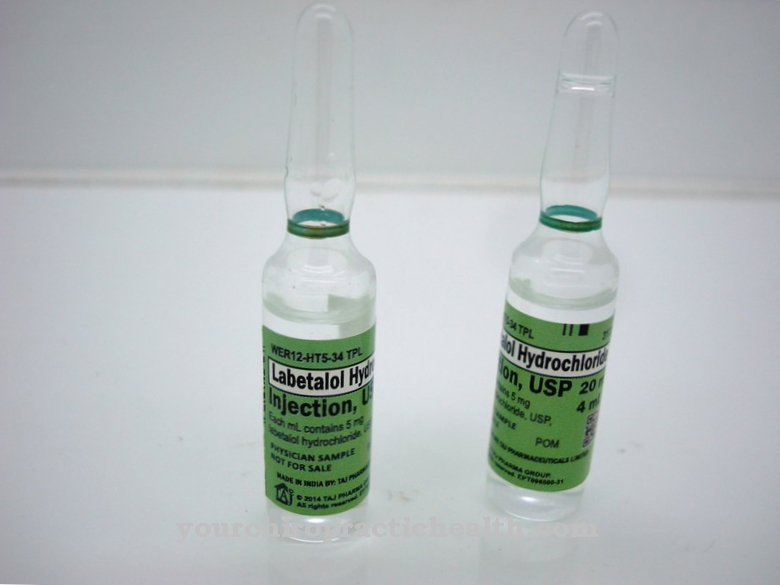Pramipexole belongs to the dopamine antagonists. The agent is used to treat Parkinson's disease.
What is Pramipexole?

Pramipexole is a drug from the group of dopamine antagonists. This means that the substance mimics the effects of natural dopamine. The drug is used to treat Parkinson's disease. Pramipexole is the standard preparation for people under 70 years of age with this disease.
A positive property of pramipexole is that its use can postpone the use of the drug levodopa in the early stages of Parkinson's disease. This is considered a benefit because levodopa has significant side effects.
Pramipexole primarily combats the tremors that are typical of Parkinson's disease. Regardless of its dosage, Pramipexole is always subject to a prescription. In Germany, Pramipexole was put into circulation in 1997 by the drug company Boehringer. The patent protection expired in 2009, as a result of which several generics could come onto the market that contain pramipexole as an active ingredient.
Pharmacological effect
In the context of Parkinson's disease, the affected people suffer, for reasons that have not yet been fully understood, from the destruction of nerve cells that release the messenger substance dopamine. However, humans cannot do without dopamine because they need it for their movements. Because of the affected nerve cells (neurons) in the substantia nigra, Parkinson's patients suffer from typical symptoms such as tremors, movement disorders and muscle stiffness. In the further course, Parkinson's disease progresses continuously.
Pramipexole is used to treat the symptoms, either alone or with levodopa. With pramipexole it is possible to fight the tremors of the patients effectively. The dopamine antagonist is mainly bound to D3 dopamine receptors, which are located on the brain cells. The binding process means that the stimuli within the brain can be better transmitted between the neurons. This gives the patient the opportunity to coordinate and implement his movements more effectively.
If Parkinson's disease is still in the early stages, the effect of pramipexole is based on its effect on the self-regulation of the control loop. The active ingredient simulates that enough dopamine is present. As a result, the nerve cells no longer overwork themselves by constantly producing dopamine.
In the late stages of Parkinson's disease, most of the dopamine-releasing neurons within the substantia nigra have already died. The pramipexole then unfolds its effect directly on the nerve cells of the striatum.
It is believed that the binding of pramipexole to the D3 dopamine receptors also has a positive effect on restless legs syndrome. According to recent studies, there is also a positive influence of the drug on bipolar disorder and depression.
The absorption of pramipexole into the bloodstream of the human body takes place through the intestines. The active ingredient reaches its maximum level after one to three hours. The pramipexole is passed on to the brain via the blood-brain barrier. There is no significant breakdown of the dopamine antagonist within the body. Around 50 percent of the remedy is passed out of the body through the urine without any changes.
Medical application & use
Pramipexole is used in all stages of Parkinson's disease. The agent can be administered alone or in combination with levodopa. It is important that the drug is administered continuously and over a longer period of time.
Another indication for pramipexole is restless legs syndrome. The drug is administered to the patient for treatment in moderate and severe cases of the disease. Restless legs syndrome leads to nervous discomfort in the legs. These are even worse at rest, which means that the legs have to move constantly. To treat restless legs syndrome, pramipexole is given individually.
Pramipexole is taken in the form of tablets. The patient initially starts with a low dose. In the further course, the dosage increases to the optimal level. The tablets are taken three times a day. The recommended dose is 3.3 milligrams. If levodopa is used at the same time, the pramipexole dose will be lower. In the case of prolonged-release tablets, only a single intake per day is required, because the active ingredient can be released from these preparations throughout the day.
You can find your medication here
➔ Medicines to calm down and strengthen nervesRisks & side effects
Taking pramipexole can be associated with bothersome side effects. Annoying side effects do not occur in all patients, as each patient reacts differently. In most cases, people will experience involuntary facial movements, low blood pressure, dizziness, nausea, and drowsiness. Other possible side effects include confusion, behavioral problems, headache, memory problems, blurred vision, restlessness, sleep problems, fatigue, weight loss, edema in the limbs, constipation and vomiting.
Disorders of the libido, falling asleep suddenly, breathing difficulties, rashes, itching and delusions are also rare. As sleep attacks can occur when taking pramipexole, it is not advisable to drive vehicles or carry out risky work.
There is a risk of interactions when pramipexole and the Parkinson’s drug amatadine and the stomach preparation cimetidine are administered at the same time. These drugs prevent the dopamine antagonist from being excreted via the kidneys. For this reason, reducing the pramipexole dosage is considered useful.
Pregnant and breastfeeding women should not take pramipexole as the effects on them and the child are unknown. Further contraindications are hypersensitivity to the active ingredient and blood washing. Serious cardiovascular diseases, delusions and psychotic disorders are also classified as questionable. If kidney function is impaired, the doctor must adjust the pramipexole dose accordingly.












.jpg)



.jpg)










.jpg)
